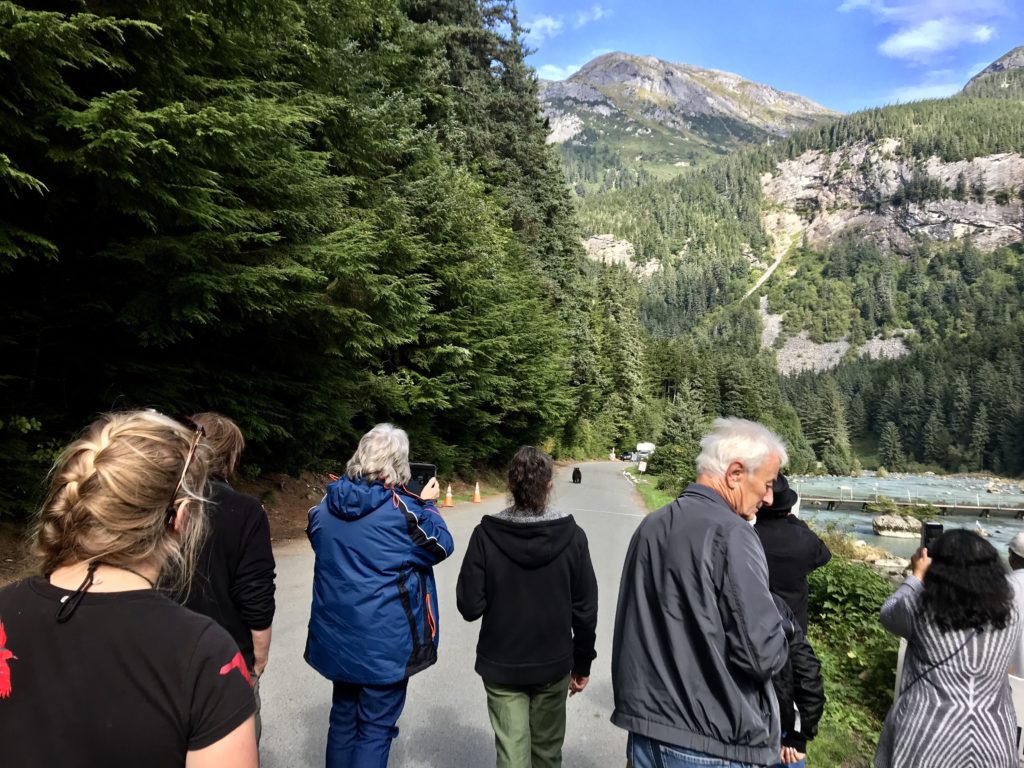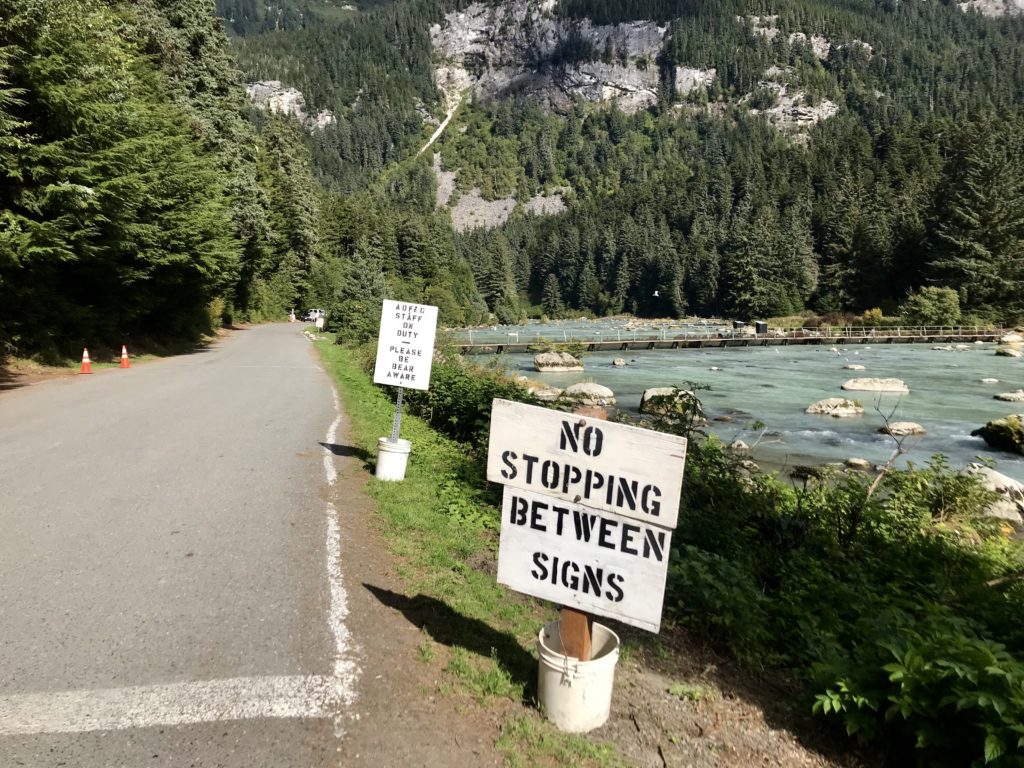
Like much of Alaska, the mountains and woods around Haines are home to many bears. For the most part, people try to avoid them. But there’s one spot where people seek them out. Bears fishing in Chilkoot River draw spectators throughout the summer and create a big safety concern. There are several people working to keep the convergence of the animals, fish and humans controlled and safe. One of them is Jamie Grubb, who works through the summer as a bear monitor for Alaska State Parks as an Alaska Conservation Corps employee.
Grubb steps out of her white and green Alaska State Parks truck around 6:30 a.m. and almost immediately spots a bear in the river.
It’s a chilly morning. The river and the road beside it are still in the shade. Grubb sips hot coffee to keep herself warm.
“What I do is I protect the bears from the people,” Grubb said. “I’m supposed to protect the people from the bears but really the bears need protection from the people because they get way too close. People get extremely close to the bears.”
This early in the morning, it’s still pretty quiet on the often busy corridor. Few humans, that is. But around a dozen coastal brown bears come and go, looking for fishy breakfast.
Later in the day, it can get really crowded with visitors and congested with their vehicles.

The bears frequent the weir, a tool used by the Alaska Department of Fish and Game to count fish returning to the river. Fish and Game provides support for bear monitoring as well.
“It’s much easier for the bears to pin the fish up against the weir than it is to chase them upstream and fight the current also,” Grubb said.
Grubb stands in the road on one side of the weir and communicates with a Chilkoot Bear Foundation board member on the other side by handheld radio. She hears that a bear named Speedy is coming down the road.
Speedy is a Chilkoot River regular. She and her three cubs parade confidently past cars, RVs and photographers.
“I love how this bear just owns the road,” Grubb said. “She just owns everything.”
Grubb is making sure cars don’t pass through the section of road in front of the weir while bears are in or approaching the corridor.
Even when there aren’t bears in the road, Grubb often stops and talks to drivers before they pass through the area.
“I try to talk to everybody before anything happens,” Grubb said. “I try to inform them of this is what’s happening, we have a lot of bears.”
That includes tour buses, shutting guests along the corridor and out to Chilkoot Lake.
“They’re on a schedule,” Grubb said. “So I try to get them through as quickly as possible. But they all seem to be sure respectful and if I ask them to wait then they understand. They’re all really good. They tour guides, they’re more help than anything actually.”
Grubb has had this job for two summers, and she says she’s never seen a dangerous situation arise between bears and human visitors. But, she says those could come up without this kind of control out there.
Grubb is very comfortable in the presence of bears. She says it’s important to understand their behavior.
“I tell people all the time, ‘we’re not a food source for them, we’re just more like mosquitos.’ We’re in their way. We’re just an irritant,” Grubb said.
Grubb points to the around 20 years experience she has working with horses.

“I think that’s the biggest part of it, is it’s a large animal, and you have to be able to read the animal correctly, and their behavior, and know what is right and what is wrong,” Grubb said.
Grubb says it’s important to move out of the animal’s way and give them plenty of space, especially sows with cubs. Near the Chilkoot weir, visitors are instructed to stay behind a designated line.
“I have photographers that come and they hide in the bushes in camouflage and they scare me,” Grubb said. “And I’m like, if you scare me, you’re going to scare a sow with cubs and then it’s going to be all over for you.”
Grubb pays close attention to the bears, scanning the road and the river, monitoring their behavior.
“Oh, here comes that little girl again,” Grubb said, referring to a single bear that’s been making attempts to fish, but getting scared away by a sow. “Honey, she’s still fishing. You’re not going to be able to get there. But see she knows there’s fish there, so she’s going to keep trying. Poor thing. Cute little thing though, huh?”
Grubb talks to the bears as they come and go, and remembers her first interaction with Speedy’s cubs.
“Of course, I was like ‘Hey, Speedy, how ya doin?’ As she was walking by I went ‘Oh! You have a cub. You have two, you have three,’” Grubb recalled. “And all three of them stood up and …they made this really weird noise that I’d never heard before and I was like ‘Hey, dudes! Get to know me, you’re going to see me all summer.’”
There are a lot more bears around this year, compared to last, says Grubb.
“Last year there wasn’t as many bears around, because there was so much fish. This year, there’s 25 bears,” Grubb said.
The Upper Lynn Canal saw a strong return of sockeye this summer. But, right now Southeast Alaska is experiencing a very low pink salmon run.
The Haines Borough is closely monitoring the congestion that comes with tourism season at Chilkoot River. Earlier this year, the Haines Assembly placed a moratorium on new tours looking to visit Chilkoot.
And recently, Fish and Game installed an electric fence on the weir, in an effort to protect the employee counting fish.
As for the day-to-day operations, Grubb says keeping bears and humans safe is a “family effort,” with many different people and groups contributing.




